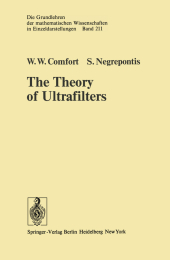 Neuerscheinungen 2011Stand: 2020-01-07 |
Schnellsuche
ISBN/Stichwort/Autor
|
Herderstraße 10
10625 Berlin
Tel.: 030 315 714 16
Fax 030 315 714 14
info@buchspektrum.de |

William Wistar Comfort, S. Negrepontis
(Beteiligte)
The Theory of Ultrafilters
Softcover reprint of the original 1st ed. 1974. 2011. x, 484 S. X, 484 p. 229 mm
Verlag/Jahr: SPRINGER, BERLIN 2011
ISBN: 3-642-65782-6 (3642657826)
Neue ISBN: 978-3-642-65782-5 (9783642657825)
Preis und Lieferzeit: Bitte klicken
An ultrafilter is a truth-value assignment to the family of subsets of a set, and a method of convergence to infinity. From the first (logical) property arises its connection with two-valued logic and model theory; from the second (convergence) property arises its connection with topology and set theory. Both these descriptions of an ultrafilter are connected with compactness. The model-theoretic property finds its expression in the construction of the ultraproduct and the compactness type of theorem of Los (implying the compactness theorem of first-order logic); and the convergence property leads to the process of completion by the adjunction of an ideal element for every ultrafilter-i. e. , to the Stone-Cech com pactification process (implying the Tychonoff theorem on the compact ness of products). Since these are two ways of describing the same mathematical object, it is reasonable to expect that a study of ultrafilters from these points of view will yield results and methods which can be fruitfully crossbred. This unifying aspect is indeed what we have attempted to emphasize in the present work.
1. Set Theory.- Ordinals.- Cardinal Arithmetic.- Notes for
1.-
2. Topology and Boolean Algebras.- Topology.- Finitary Properties of Boolean Algebras.- Stone´s Duality.- The Completion of a Boolean Algebra and the Gleason Space of a Compact Space.- Notes for
2.-
3. Intersection Systems and Families of Large Oscillation.- Intersection Systems and the Souslin Number.- Families of Large Oscillation.- Notes for
3.-
4. The General Theory of Jönsson Classes.- Notes for
4.-
5. The Jónsson Class of Ordered Sets.- Notes for
5.-
6. The Jónsson Class of Boolean Algebras.- The Stone Space of the Homogeneous-Universal Boolean Algebras.- Properties of the Space S?.- Notes for
6.-
7. Basic Facts on Ultrafilters.- Notes for
7.-
8. Large Cardinals.- Weakly Compact Cardinals: Combinatorial Equivalences.- Weakly Compact Cardinals: Boolean-Algebraic and Topological Equivalences.- Measurable Cardinals.- Descendingly Incomplete Ultrafilters.- Notes for
8.-
9. The Rudin-Keisler Order on Types of Ultrafilters.- The Rudin-Keisler Order.- Rudin-Keisler Minimal Types in ?[?(?)\?].- Good Ultrafilters.- Notes for
9..-
10. Good Ultrafilters.- Families of Large Oscillation Modulo Filters; the Fundamental Existence Theorem of Good Ultrafilters.- Additional Existence Results.- Directedness Properties of the Rudin-Keisler Order.- Adequate Ultrafilters on Special Boolean Algebras.- Notes for
10.-
11. Elementary Types.- Notes for
11.-
12. Families of Almost Disjoint Sets.- Cardinalities of Families of Almost Disjoint Sets.- The Balcar-Vop?nka Theorem.- Cardinalities of Ultraproducts.- Notes for
12.-
13. Saturation of Ultraproducts.- Ultraproducts Modulo Regular Ultrafilters.- Ultraproducts Modulo Good Ultrafilters.- Shelah´s Characterisation of Elementary Equivalence.- Characterisation of the Rudin-Keisler Order.- Notes for
13.-
14. Topology of Spaces of Ultrafilters.- Certain Properties of F?-Spaces.- The Space of ?-Uniform Ultrafilters on ?.- Spaces of Uniform Ultrafilters and Homogeneous-Universal Boolean Algebras.- The Space of Sub-Uniform Ultrafilters.- Relations to Measurable Cardinals.- Notes for
14.-
15. Spaces Homeomorphic to (2?)?.- The Topological Characterization of (2?)?.- The Baire Category Properties of (2?)?.- Spaces of Ultrafilters Homeomorphic to Spaces (2?)?.- Applications to the Growth Spaces ?X\X.- Notes for
15.-
16. Ultrafilters on ?.- The Rudin-Keisler Order on ?(?) and the Canonical Function ?:?(? ?) ? ?(?) ?(?).- The Rudin-Frolík Order.- Non-Homogeneity of Certain Spaces.- Notes for
16.- Index of Symbols.


